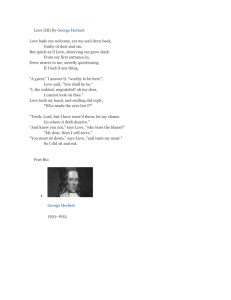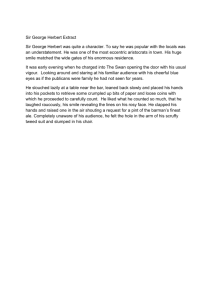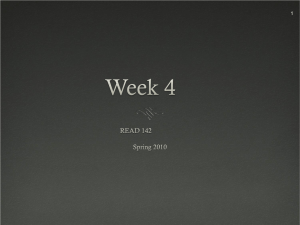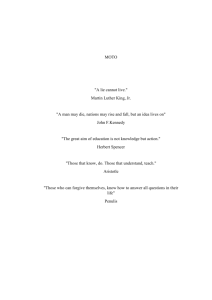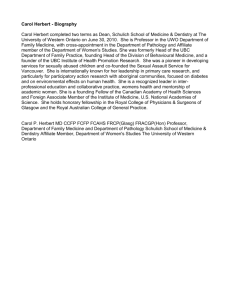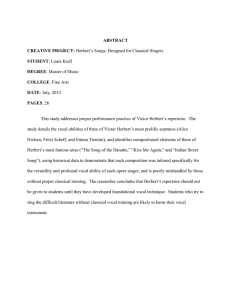Jenny E. Kim 5/3/06
advertisement
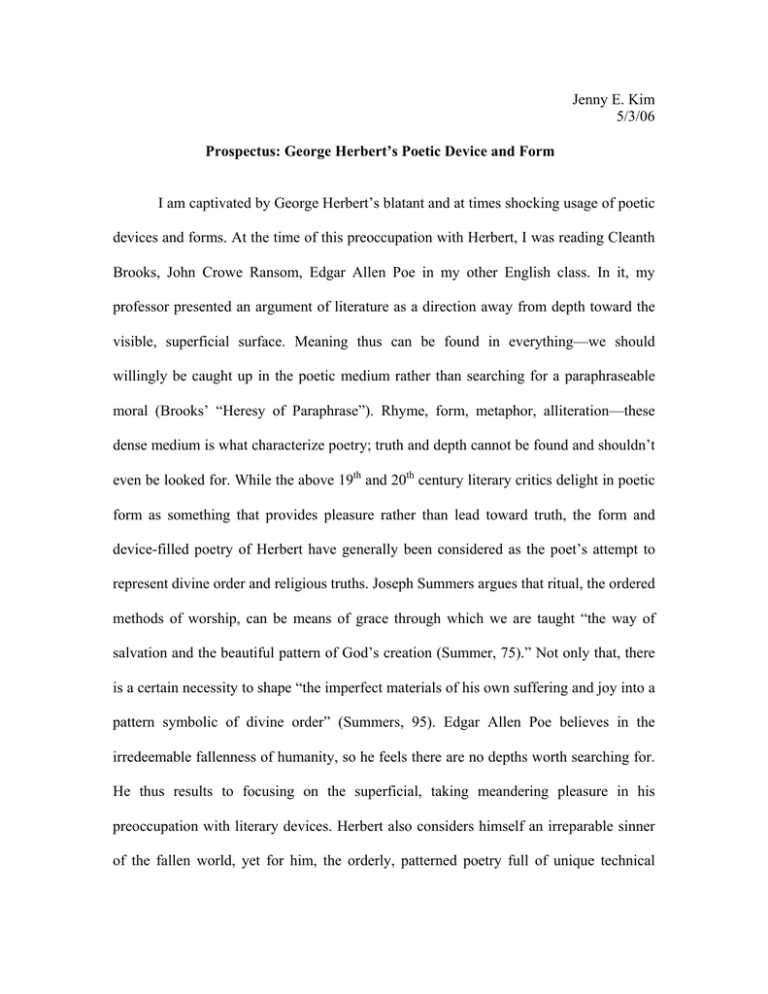
Jenny E. Kim 5/3/06 Prospectus: George Herbert’s Poetic Device and Form I am captivated by George Herbert’s blatant and at times shocking usage of poetic devices and forms. At the time of this preoccupation with Herbert, I was reading Cleanth Brooks, John Crowe Ransom, Edgar Allen Poe in my other English class. In it, my professor presented an argument of literature as a direction away from depth toward the visible, superficial surface. Meaning thus can be found in everything—we should willingly be caught up in the poetic medium rather than searching for a paraphraseable moral (Brooks’ “Heresy of Paraphrase”). Rhyme, form, metaphor, alliteration—these dense medium is what characterize poetry; truth and depth cannot be found and shouldn’t even be looked for. While the above 19th and 20th century literary critics delight in poetic form as something that provides pleasure rather than lead toward truth, the form and device-filled poetry of Herbert have generally been considered as the poet’s attempt to represent divine order and religious truths. Joseph Summers argues that ritual, the ordered methods of worship, can be means of grace through which we are taught “the way of salvation and the beautiful pattern of God’s creation (Summer, 75).” Not only that, there is a certain necessity to shape “the imperfect materials of his own suffering and joy into a pattern symbolic of divine order” (Summers, 95). Edgar Allen Poe believes in the irredeemable fallenness of humanity, so he feels there are no depths worth searching for. He thus results to focusing on the superficial, taking meandering pleasure in his preoccupation with literary devices. Herbert also considers himself an irreparable sinner of the fallen world, yet for him, the orderly, patterned poetry full of unique technical components provide a possibility for deeper connection with the divine. It is my aim in the paper to consider the kind of function Herbert’s poetic devices serve—whether it is the necessary written “ritual” through which men can reach the divine (this sense is also evoked by Milton in Paradise Lost after the fall of Adam and Eve), or it ultimately strays both the reader and the writer away to unparaphrseable meandering pleasure. I plan to focus on Herbert’s poems that strike me as most shocking it their techniques—“The Altar,” “Easter Wings,” “Sinnes round,” “Deniall,” “The Flower,” “Paradise,” and “Colossians 3:3.” Through the close analysis of the poems and their poetic devices, I attempt to discover whether they are necessary components for man’s connection with divine or required facets that makes poetry an experience or a journey that is independent of any depth or truth. I will supplement my discussion with some of the most important and contradicting Herbert critics of the past century: Empson, Rosamond Tuve, Joseph Summers, Stanley Fish, Helen Vendler, and Barbara Lewalski. In Barbara Harman’s book, which took up a discussion of all the above critics, I was able to locate myself within the modern discourse on Herbert. The poet’s relation to and independence from culture and the question of whether poetry empowers or disables the poet shed light to my own project. My project attempts to see whether poetic devices further validate the artist or cause him to dissipate1 as independent “experience” of the reader made possible by those very devices, gain importance. 1 This idea is derived upon reading Stanley Fish’s argument in Self-consuming Artifacts: the experience of seventeenth century literature. Annotated Bibliography Beaston, Lawrence. “Talking to a Silent God: Donne’s Holy Sonnets and the Via Negativa.” Renascence 51 (Winter, 1999): 95-109. I read the article at the very beginning of my endeavors, as I was thinking of studying either or both of Donne and Herbert’s religious poetry. The author points out that instead of the figure of God as a dramatic personae (as in Herbert), Donne’s God “refuses to be caught in the constructions of human reason and human language.” This notion is important to think about, because even though Herbert may attempt to encounter God directly and personally in his poems, he might not be able to achieve that intimacy, even through his usage of literary devices. Coleridge, Samuel T. from ‘Biographia Literaria’, 1817; ‘The Friend’, 1818 etc. George Herbert: The Critical Heritage. Ed. By C.A. Patrides. London: Routledge & Kegan Paul, 1983. Knowing that Coleridge thinks of himself with the following description: “selfcontempt, utter disproportionateness of all I can call me, to the promise of the gospel… I should be left to myself to sink into chaos and lawless productivity of my own still perishing yet imperishable nature (169)”, it is interesting to read his praising Herbert during the time where Herbert was belittled and looked down upon. Elliot, T.S. George Herbert, in the ‘Spectator’, 1932. GeorgeHerbert: The Critical Heritage. Ed. By C.A. Patrides. London: Routledge & Kegan Paul, 1983. According to Elliot, Herbert only wrote few good poems worthy of being included in an anthology. In order to understand him fully, the reader has to be on par with what mattered to Herbert the most. Harman, Barbara L. Costly Monuments: Representations of the Self in George Herbert’s Poetry. Cambridge, MA: Harvard University Press, 1982. Harman situates herself within the important and at times contradictory discourse on Herbert by Empson, Rosamond Tuve, Joseph Summers, Stanley Fish, Helen Vendler, and Barbara Lewalski. The important questions lie in this: Does the writer have authority to shape culture? Or are writers ultimately tied to their relationship to culture and history? Does this tie to culture empower writers’ sense of self or cause dissolution? In this discussion of the selfhood, I also ask, along with Summers, whether the obsession with the self is equivalent to the distrust of God. In addition, was representation of the self (in the way we modern readers think of it) even important for Herbert? Harman’s argument is one that mediates the above contradictions. She states that “culture is neither disabling or enabling” and she synthesizes the possibilities of both. These major issues in the study of Herbert is useful for my own preoccupation with form and technical devices. The form can dissolve the poet or the issues that mattered most to him and instead focus on the readers’ experience of meandering through the technicalities of the poem (argument associated with that of Stanley Fish—I plan on reading Stanley’s Fish’s books “Self Consuming Artifacts” and “The Living Temple: George Herbert and Catechizing”). On the other hand, Herbert has, through the same devices, made personal the scripture (argument derived from Lewalski) and in turn grew closer to the religious truths. This book has pointed me to look more closely at different sources and critics. Stanwood, P.G. “The Vision of God in the Sonnets of John Donne and George Herbert.” John Donne Journal; studies in the age of Donne, 21 (2002): 89-100. This is another article of comparison between Donne and Herbert and their religious poetry. Whereas many previous writers prefer Donne over Herbert, the author of this article values Herbert’s serenity and Donne’s paradoxical and thus unresolved struggle equally. Summers, Joseph H. George Herbert: His Religion and Art. London:Chatto and Windus Ltd., 1954. Summers’ arguments, especially in the chapters “The Conception of Form” and “The poem as Hieroglyph” helped me to concretely formulate my questions on Herbert’s poetic form. Summers believes that while Herbert “could never allow the ritual to become a substitute for incorporeal experience… individual should not present himself, publicly at least, in disorder before God.” In addition, pattern symbolic of divine order can effectively lead him and others to the knowledge of salvation and worship. One of the most striking statements concerning form is that it shapes the “imperfect material of his [Herbert’s] own suffering and joy into a pattern symbolic of divine order.” The sense of imperfection is inherent in the writings of Poe, Ransom, Brooks etc. as well as in Herbert. To me, it seems that this same sense of “fallenness” leads poetry into two divergent paths—1) to focus on the poetic devices as a means through which you can “experience” life in all its unexplainable varieties on the basis that no truth exists, and 2) as in Summers’ Herbert, poetic devices are used to resemble the pure authority of the divine. Tomlinson, T.B. “Poetry and Belief in Seventeenth-Century England: George Herbert.” Critical Review 31 (1991): 103-15. The author claims that Herbert’s poems have too much tendency to take refuge from doubts and struggles. Even the doubts he raises very poignantly are quickly resorted to encapsulated truisms. The author firmly believes that Herbert’s best poems are the ones where he raises questions and uncertainties. I question however, if the apparent division of the self, is the only criteria for a successful poem. There has been a tradition of applauding all things that appear unresolved, paradoxical, and irredeemably divided. Does the “seeming” (we can never say for sure that the sense of certainty in Herbert is completely proven) wholeness of Herbert detracts his ability as a poet?
